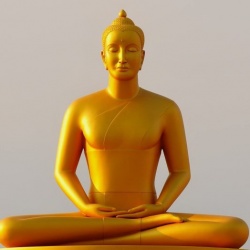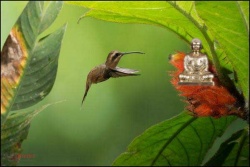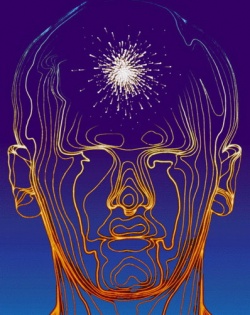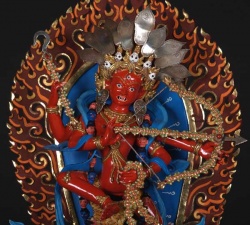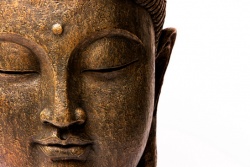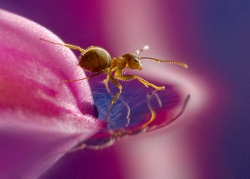Nyingma Lineage Supplications
This liturgy is a collection of short supplications to Nyingma lineage holders from a variety of sources.
This particular compilation is used at Namdroling Monastery in South India.
Traditionally, Namdroling khenpos chant this before presenting teachings at the shedra.
Unless noted otherwise, the authorship of individual stanzas is unknown.
The initial paragraph addresses one’s root guru.
The guru is said to be the essence of all the buddhas, the essence of the five buddha families.
The mandala is said to be displayed from the mind of the guru.
The author of the first four verses is uncertain.
According to one source, they were composed by Jamgön Mipham Gyatso; according to another, by Longchenpa.
The first verse is a supplication to Shakyamuni Buddha.
In the fourth line, “Lord of Sages” and “White Lotus” are epithets of the Buddha.
This verse employs the imagery of the parts of a flower: pistil, anthers, and petals.
The pistil of a flower is located at its center, and is surrounded by the anthers, which are in turn surrounded by the petals. Opinions vary as to which Tibetan word refers to which part of a flower, so these terms cannot be taken scientifically.
They mainly serve a poetic function.
The second verse is a supplication to Padmakara.
“Emanation of a victorious one” refers to Buddha Amitabha.
“Lake of Uddiyana” is lake Dhanakosha, where Padmakara emerged from a lotus flower.
In the third verse, a supplication to Manjushri, Manjushri is likened to the moon.
“Friend of the kunda” is a traditional epithet of the moon.
The kunda flower seems to be white jasmine, which is a night-blooming flower.
The flower is likened to our minds, which “blossom” through the power of Manjushri, just as the moon helps the flower to blossom. In the fourth line, “lotus mudra” is the same as anjali.
The fourth verse is a supplication to Sarasvati.
In the second line, her speech is likened to the sun, in contrast to her consort Manjushri, who is likened to the moon in the previous verse.
Net of a thousand light rays” is a traditional epithet of the sun.
Verse five is very famous, though its author is unknown. According to some explanations, Nagarjuna, Aryadeva, Asanga, Vasubandhu, Dignaga, and Dharmakirti are the six “ornaments,” and Gunaprabha and Shakyaprabha are the two “supreme ones.”
According to other explanations, Nagarjuna and Asanga are the two “supreme ones,” as well as being part of the group of six ornaments.
Aryadeva was the student of Nagarjuna, and Vasubandhu was the student (and younger brother) of Asanga.
Dharmakirti is the (indirect) student of Dignaga.
The students were the major commentators on their teacher’s teachings. Dharmapala was another important commentator, in the yogachara tradition. Both Gunaprabha and Shakyaprabha were known for their mastery of and commentaries on the vinaya. AcharyaShura was probably the author of the Jataka-mala, a collection of stories of the Buddha’s previous lives.
Verse six appears in many places, such as in The Rain of Blessings, our sangha’s Padmasambhava feast practice.
It is a supplication to a number of forefathers of the Nyingma lineage.
The Indian guru, Prahevajra, the first human lineage holder, is more commonly known by the Tibetan translation of his name, Garap Dorje (“Indestructible Supreme Joy”). Shri Simha was one of Padmakara’s principal gurus.
“Lord and subjects—the twenty-five” refers to King Trisong Detsen and the other twenty-four close disciples of Padmakara.
“So, Sur, Nup, and Nyak” refer to figures in the kama lineage, which is the transmission from teacher to student of the tantric teachings of the Buddha. “Hundred tertons” refers to the terma lineage of those who reveal the hidden dharma treasures of Padmakara.
Verse seven, composed by Jamgön Mipham Gyatso, supplicates Rongsom Chokyi Sangpo, who is said to have written sixty volumes of text, which were subsequently lost.
The use of the adjectives “glorious and gentle” in the third line liken Rongsom Chokyi Sangpo to Manjushri.
The eighth verse, a supplication to Longchenpa, may have been composed either by Longchenpa himself or by Jamgön Mipham Gyatso. “Pleasure Grove” is the name of Longchen Rabjam’s retreat cave in Upper White Snow Mountain.
“Hidden yogin” refers to practitioners who keep their good qualities secret, pretending to be ordinary.
The ninth verse, a supplication to Patrul Rinpoche, was written by Jamyang Khyentse Wangpo on the back of a thangka.
It is said that Patrul Rinpoche reacted to it by running away, as he did not like supplications addressed to himself. “Self-Liberated Suffering” is an epithet of Avalokiteshvara.
Verse ten was composed by Jamgön Mipham Gyatso as a supplication to himself for his students. According to the Sutra of Extensive Play, the eight great treasures of confidence are;
(1) the recollection that overcomes forgetfulness,
(2) the intellect that develops the mind,
(3) the realization that completely grasps the meaning of all sutras,
(4) the retention of all that one has heard,
(5) the brilliance that delights all sentient beings with excellent exegeses,
(6) the doctrine that well preserves the sacred teachings,
(7) the enlightenment that never breaks its relationship with the three precious jewels, and
(8) the accomplishment that is receptive to the uncreated reality of emptiness.
(Adapted from The Nyingma School of Tibetan Buddhism, Its Fundamentals and History, vol. 2, p. 160.). Mipham Manjugosha is Sanskrit meaning “Mipham Gentle Voice.”
Here, “gentle” means that his voice was perfect and could reach all beings—not that it was soft in tone or that it was a good singing voice.
In verse eleven, “arts and sciences” is Western term for what was traditionally called the “five sciences,” which comprised a basic general education.
Verse thirteen is excerpted from the Prajnaparamita Sutra. Verse fourteen is the eighteenth verse of The King of Aspirations Prayer by bodhisattva Samantabhadra (the last chapter of the Gandavyuha Sutra).
In verse fourteen, nagas are a type of nonhuman being with snakelike characteristics, who live in close association with water. Yakshas are another nonhuman class of being. Kumbhandas are a kind of yaksha that have the heads of animals and the bodies of humans.
The final two verses are separated from the rest of the text by asterisks because they would traditionally be chanted by only the teacher. At this time, it is uncertain how they will be used in our community.
